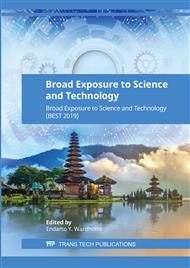[1]
E.A. Kamoun, E-R.S. Kenawy and X. Chen, Journal of Advanced Research 8 (3) (2017) 217-233.
Google Scholar
[2]
K. Vowden and P. Vowden, Surgery (Oxford) 35 (9) (2017) 489-494.
DOI: 10.1016/j.mpsur.2017.06.005
Google Scholar
[3]
H.N. Li, J. Yang, X.N. Hu, J. Liang, Y.J. Fan and X.D. Zhang, J. Biomed. Mater. Res. A 98 (2011) 31-39.
Google Scholar
[4]
J. Koehler, F.P. Brandl and A.M. Goepferich, European Polymer Journal 100 (2017) 1-11.
Google Scholar
[5]
T. Wang, X-K. Zhu, X-T. Xue and D.Y. Wu, Carbohydrate Polymers 88 (2012) 75-83.
Google Scholar
[6]
D. Mukherjee, Md. Azamthulla, S. Santhosh, G. Dath, A. Ghosh, R. Natholia, J. Anbu, B.V. Teja and K.M. Muzammil, Journal of Drug Delivery Science and Technology 46 (2018) 498-510.
DOI: 10.1016/j.jddst.2018.06.008
Google Scholar
[7]
S. Anjum, A. Arora, M.S. Alam and B. Gupta, International Journal of Pharmaceutics 508 (1-2) (2016) 92-101.
Google Scholar
[8]
S. Sharma, R. Kumar, P. Kumari, R.N. Kharwar, A.K. Yadav and S. Saripella, International Journal of Biological Macromolecules 125 (2019) 109-115.
DOI: 10.1016/j.ijbiomac.2018.12.018
Google Scholar
[9]
E.M. de A. Braz, S.C.C.C. e Silva, D.A. da Silva, F.A. de A. Carvalho, H.M. Barreto, L. de S.S. Júnior and E.C. da S. Filho, International Journal of Biological Macromolecules 117 (2018) 640-647.
DOI: 10.1016/j.ijbiomac.2018.05.205
Google Scholar
[10]
Y. Chen, Y. Zhang, F. Wang, W. Meng, X. Yang, P. Li, J. Jiang, H. Tan and Y. Zheng, Material Science and Engineering C 63 (2016)18-29.
Google Scholar
[11]
G. Michailidou, E. Christodoulou, S. Nanaki, P. Barmpalexis, E. Karavas, S. Vergkizi-Nikolakaki and D.N. Bikiaris, Carbohydrate Polymers (2019) 208 1-13.
DOI: 10.1016/j.carbpol.2018.12.050
Google Scholar
[12]
Y. Xie, Z-X. Yi, J-X. Wang, T-G. Hou and Q. Jiang International Journal of Biological Macromolecules 112 (2018) 1225-33.
Google Scholar
[13]
S. Jiang, S. Liu and W. Feng, Journal of the Mechanical Behavior of Biomedical Materials 4 (7) (2011)1228-1233.
Google Scholar
[14]
I. Bano, M. Arshad, T. Yasin and M.A. Ghauri, International Journal of Biological Macromolecules 124 (2019)155-62.
Google Scholar
[15]
A. Ali, Md.A. Shahid, Md.D. Hossain and Md.N. Islam, International Journal of Biological Macromolecules In Press Accepted Manuscript DOI 10.1016/j.ijbiomac.2019.07.015 (2019).
Google Scholar
[16]
K.Y. Lee and D.J. Mooney, Progress in Polymer Science 37 (1) (2012) 106-126.
Google Scholar
[17]
Y. Tang, X. Lan, C. Liang, Z. Zhong, R. Xie, Y. Zhou, X. Miao, H. Wang and W. Wang, Carbohydrate Polymers 219 (2019) 113-120.
DOI: 10.1016/j.carbpol.2019.05.004
Google Scholar
[18]
H. Mndlovu, L.C. du Toit, P. Kumar, T. Marimuthu, P.P.D. Kondiah, Y.E. Choonara and V. Pillay, Carbohydrate Polymers 222 (2019) 114988.
DOI: 10.1016/j.carbpol.2019.114988
Google Scholar
[19]
H. Kaygusuz, E. Torlak, G. Akın-Evingür, İ. Özen, R. von Klitzing and F.B. Erim, International Journal of Biological Macromolecules 105 (1) (2017) 1161-1165.
DOI: 10.1016/j.ijbiomac.2017.07.144
Google Scholar
[20]
C.A. Stone, H. Wright, T. Clarke, R. Powell and V.S. Devaraj, Br. J. Plast. Surg. 53 (2000)601-6.
Google Scholar
[21]
M.T. Longaker, E.S. Chiu, N.S. Adzick, M. Stern, M.R. Harrison and R. Stern, Ann. Surg. 213 (1991) 292–6.
Google Scholar
[22]
J.M. Rosiak, I. Janik, S. Kadlubowski, M. Kozicki, P. Kujawa, P. Stasica and P. Ulanski, Nuclear Instruments and Methods in Physics, Research Section B: Beam Interactions with Materials and Atoms 208 (2003) 325-330.
DOI: 10.1016/s0168-583x(03)00627-x
Google Scholar
[23]
E.A. Kamoun, El-R.S. Kenawy, T.M. Tamer, M.A. El-Meligy and M.S.M. Eldin, Arabian Journal of Chemistry 8 (1) (2015) 38-47.
DOI: 10.1016/j.arabjc.2013.12.003
Google Scholar
[24]
D.R. Barleany, I.P. Alim, N. Rizkiyah, U.T. Lusi, H. Heriyanto and Erizal, International Conference on Technology, Innovation, and Society (ICTIS) 2016 Proceeding (Padang July 21-22 Indonesia) 978-602-70570-4-3 DOI 10.21063/ICTIS.2016.1099 (2016).
DOI: 10.21063/ictis.2016.1099
Google Scholar
[25]
E.D.T. Atkins, W. Mackie and E.E. Smolko, Nature 225 (1970) 626-628.
Google Scholar


